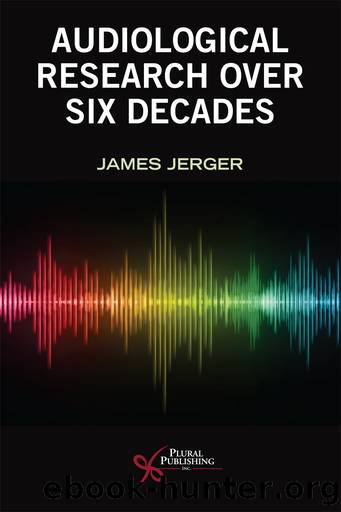Audiological Research Over Six Decades by James Jerger;

Author:James Jerger;
Language: eng
Format: epub
Publisher: Plural Publishing Inc.
Published: 2021-08-15T00:00:00+00:00
Figure 4â4. Sound localization accuracy scores; comparison with an age- and sex-matched young adult with normal hearing. Errors are represented as deviations from the diagonal lines. Signals were 10-second, 1000-Hz tone bursts. Modified from Figure 20 in Jerger et al. (1969).
âDo you want me to tell you where the sound starts or where it ends?â We were dumbfounded!
Further questioning established that all of the sounds, except the clicks, moved in space over the 10-second sound duration, almost always from left to right. We were frankly astonished. We are always prepared to expect the unexpected in cases of brain injury, but the idea that a sound emanating from a fixed location in space could be heard as moving from its initial position to a different final position was certainly not expected.
As it turned out, the answer was disarmingly simple. There is a mechanism in audition that might be termed âcritical on time.â For very short sounds, there is a trade-off between threshold and duration. At 1000 Hz, for example, over the first 1,000 ms of sound duration, the threshold gradually improves by about 20 dB in a normal system. If you substitute âloudnessâ for âthreshold,â you will begin to see where I am going with this. The answer to the apparent mystery of why a stationary sound can seem to move in space is illustrated in Figure 4â5. You will remember this figure from Chapter 3, where it appeared, for a different purpose, as an example of how critical on-time can be affected by temporal lobe disorder.
In persons with normal auditory systems, the trade-off between threshold-versus-duration functions for the two ears will be similar. As a sound at 0 degrees azimuth progresses over the first 1,000 ms, loudness will rise equally in the two ears; the 10-second tone burst will be perceived as either directly ahead or directly behind the listener. This provides an important clue to localization. As the sound source moves away from the midline and toward the right sound field, a âhead shadowâ effect will attenuate slightly the loudness at the left ear, shifting the apparent location toward right auditory space. Moving the sound source away from the midline toward left auditory space will move the apparent source of the sound toward the left space as well. In both cases, the head shadow effect creates a clue to the location of the sound. But suppose that loudness increases differently on the two ears over the first 1,000 ms. This is precisely what Figure 4â5 demonstrates in our airman. At a duration of 20 ms, the difference between thresholds (i.e., loudness) was an astonishing 50 dB. Then, as duration increased, the difference between thresholds gradually decreased to only about 6 dB. Is it any wonder that, for him, the sound seemed to move from left to right?
Download
This site does not store any files on its server. We only index and link to content provided by other sites. Please contact the content providers to delete copyright contents if any and email us, we'll remove relevant links or contents immediately.
| Administration & Medicine Economics | Allied Health Professions |
| Basic Sciences | Dentistry |
| History | Medical Informatics |
| Medicine | Nursing |
| Pharmacology | Psychology |
| Research | Veterinary Medicine |
Bioenergetica by Alexander Lowen(1360)
The Child in You by Stefanie Stahl(1139)
Noise: A Flaw in Human Judgment by Sunstein Cass R. & Sibony Olivier & Kahneman Daniel(1106)
No Bad Parts by Richard C. Schwartz(1074)
The Data Detective by Tim Harford(1054)
Chatter by Ethan Kross(977)
The Science of Rapid Skill Acquisition by Peter Hollins(831)
Freedom by Sebastian Junger(765)
The Montessori Baby by Simone Davies(739)
The Quantum Psychiatrist: From Zero to Zen Using Evidence-Based Solutions Beyond Medication and Therapy by Biswas Dona(731)
Maps of Meaning: The Architecture of Belief by Jordan B. Peterson(666)
Evolution Gone Wrong: The Curious Reasons Why Our Bodies Work by Alex Bezzerides(637)
The Science of Self-Learning: How to Teach Yourself Anything, Learn More in Less Time, and Direct Your Own Education (Learning how to Learn Book 1) by Peter Hollins(624)
Anxiety For Dummies by Charles H. Elliott & Laura L. Smith(595)
Why Sex Doesn't Matter by Olivia Fane(592)
Sadomasochism and the BDSM Community in the United States by Stephen K. Stein(592)
Disconnected by thomas Kersting(587)
Jung - The Key Ideas: Teach Yourself (TY Philosophy) by Ruth Snowden(560)
The Mechanics of Passions: Brain, Behaviour, and Society by Alain Ehrenberg(557)
